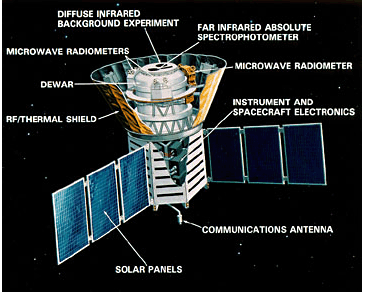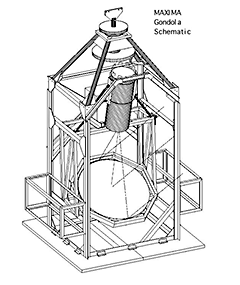 |
||
|
|
 |
|
|
The most conclusive evidence for The Big Bang is the isotropic radiation that permeates the entire universe - the Cosmic Microwave Background (CMB). It was first predicted by Ralph Alpher, Robert Herman, and George Gamow in 1948 while working on Big Bang Nucleosynthesis. In 1964, Arno Penzias and Robert Wilson were attempting to distinguish and measure sources of noise in a radio receiver they built at Bell Labs. They found that a persistent signal occurred regardless of the antenna's direction. At nearby Princeton University, researchers Robert Dicke and Dave Wilkinson were designing an experiment to find the CMB. When they heard about Penzias and Wilson's work, they knew the CMB was the source of the excess noise - the relic radiation of the Big Bang. Penzias and Wilson received the Nobel Prize for their discovery in 1978. The above image is a Wilkinson Microwave Anisotropy Probe (WMAP) map of the CMB. WMAP is a NASA Explorer mission that launched June 2001 to make fundamental measurements of cosmology. Although the temperature of the CMB is almost completely uniform at 2.7 K, the map shows there are tiny variations, or anisotropies, in the temperature on the order of 10-5K. The anisotropies appear on the map as cooler blue and warmer red patches.These anisotropies, or "ripples" in the temperature map, correspond to areas of various density fluctuations in the early universe. Eventually, gravity would draw these fluctuations into even denser areas. After billions of years and gravitational attraction, these minute ripples in the early universe evolved into the planets, stars, galaxies, and clusters of galaxies that we see today.
Studying the CMB reveals conditions of the early universe. Experiments include:
Dark energy is the name given to the unknown physics causing the current acceleration of the cosmic expansion. Whether dark energy is truly a new component of energy density or an extension of gravitational physics beyond general relativity is not yet known. The consequences of dark energy for fundamental physics will not be clear until its origin is discovered, but the effects on the universe are dramatic. Dark energy effectively contributes 70-75% of the current energy density of the universe, governing the expansion of space, causing it to accelerate over the last ~5 billion years, and will determine the fate of the universe. Such a phenomenon is not predicted within the standard model of particle physics nor within experimental experience of gravity as an attractive force. BCCP explores dark energy from many directions, including theory, computer simulations, and diverse experimental projects. We look at the ties to high energy physics, quantum physics, and gravity and investigate its signatures on supernova distances and cosmic structure over the history of the universe. Dark Energy Theory by Eric Linder
Dark Energy investigations:
We believe that most of the matter in the universe is dark - it cannot be detected from the light which it emits (or fails to emit). Its presence is inferred indirectly from the motions of astronomical objects - specifically stellar, galactic, and galaxy cluster/supercluster observations. Dark matter has measurable effects on the anisotropies observed in the cosmic microwave background and plays a central role in the modeling of structure formation and galaxy evolution (shown in this NASA ESA image). We have four lines of evidence for dark matter in cosmology: the formation of large scale structure in the length of time since decoupling requires it; the limits on the baryon density from primordial nucleosynthesis requires it; the velocities of stars within galaxies and of galaxies with clusters require it; leading theories of particle physics predict it. The cosmological effects of dark matter on cosmic structure provide one of the best windows on this physics beyond the Standard Model of particle physics. Dark matter was postulated by Fritz Zwicky in 1934, to account for evidence of "missing mass" in the orbital velocities of galaxies in clusters. According to new supernova observations and Big Bang cosmology, dark matter accounts for 23 percent of the total mass-energy of the observable universe. Dark matter comprises about 6 times more matter than ordinary baryons do. Dark Matter Theory by Martin White
Dark Matter investigations:
Theoretical cosmology involves analysis of data with an eye to current theories, making predictions from theories and coming up with theories. It includes a wide range of topics, from dark energy, inflation, dark matter and neutrino masses to galaxy and cluster formation, reionization and structure formation (e.g. characterization of emergent phenomena such as the cosmic web or the regularities observed in galaxy properties). For many of the physical cosmology problems, numerical simulation in particular is extremely useful, and in fact crucial, for incorporating correlations implicit in the cosmic web and providing a framework for evolution within it. A flood of observational data has become available in recent years, and is growing steadily. Currently, in many parts of physical cosmology, theory is racing to keep up and to make testable predictions for observations, as the latter grow in precision and richness.
Galaxy and Distant Object Observations Galaxy & Extremely Distant Object Observations map the baryonic or "regular matter" in the universe, giving us an incomplete description and missing the majority of stuff in it - including dark matter and dark energy. However, combining our models and indirect measurements of dark matter and energy with precise surveys, systematically mapping galaxies in the universe is the most powerful cosmological tool available. The Far-Infrared background (Far IR) measurements improve our understanding of the structure of the universe and the galaxy population mix at a distance of about 7-11 billion light years. Far IR also reveals the evolution of dusty starburst galaxies, and the measurement of the 'bias' - the ratio of baryonic to total matter in the universe. The Big BOSS project aims to measure the distribution of baryonic matter in bright galaxies and quasars over the entire sky out to a distance of nearly 14 billion light years. Such exquisitely precise baryonic mapping will permit a huge leap in our understanding of dark energy. Baryonic mapping provides an improved measurement of the equation of state of the universe in addition to numerous other improved cosmological measurements - even an improved measurement of neutrino masses. Big BOSS measures the appearance of an cosmic "standard ruler", the acoustic oscillations in the early universe. See the full explanation here. BCCP scientists are involved in a project to measure very early optical light from gamma-ray bursts, the Ultra-Fast Flash Observatory. Gamma-ray bursts give us a view of some of the most distant objects known, so far up to 18 billion light years away. These objects may turn out to be a type of "calibratable" standard candle, in which case they would give us the best picture of our universe at extreme distances.
Galaxy and Distant Object Observations:
High Energy Physics and Cosmology
BCCP Major Projects
BOSS (Baryon Oscillation Spectroscopic Survey) BCCP cosmologists are world leaders in the newest approach to dark energy measurements - Baryon Acoustic Oscillations (BAO). By studying the clustering of nearby galaxies, we can detect the imprint of the sound waves that were “frozen in” as the cosmic plasma of the early universe cooled — the same acoustic phenomena that produced the anisotropies we see in the Cosmic Microwave Background (CMB). By comparing the structure in the CMB with the distribution of galaxies in the near universe, we obtain a measurement of the properties of dark energy causing the recent cosmic acceleration. This gives a new window on the phenomenon, which is independent of the one using supernovae, providing a complementary way of understanding the history of the universe and what drives it. The Center’s scientists are developing a new project that can make a dramatic step forward in BAO dark energy measurements. The survey is designed to obtain spectra of 1.5 million galaxies at z<0.7, and 160,000 quasars for the BAO signal at much higher redshifts.
PolarBeaR (Polarization of Background Radiation) BCCP scientists are at the forefront of CMB instrumentation developments. We have instruments running on several cutting-edge experiments, including the Planck satellite and the South Pole Telescope, which is currently collecting the best data of small angular scale anisotropies. The Planck satellite was launched on May 14, 2009. BCCP Director George Smoot has been involved in the Planck mission since its inception, and is a senior member of the project. PolarBeaR is undergoing construction and will eventually observe from the high Atacama Desert in Chile, with even better sensitivity although over a smaller area of sky. The ambitious goal of this work is to search for the signature of gravity waves from the inflationary era of the universe 10-35 seconds after the Big Bang at energies of 1016 GeV. Such a discovery would reveal the universe at energy scales that probe fundamental physics beyond the reach of particle accelerators - a critical step in efforts to map the entire history of the universe. These projects illustrate the diverse capabilities of BCCP, including:
The Legacy Supernova Calibration Program All of the major programs proposed for the next decade that use supernovae to study dark energy will require a novel supernova calibration program. These include the dramatic example of the JDEM satellite project supernova probe and the Nearby Supernova Factory, a key element of JDEM that demonstrated the basic steps required. Our next task will be to design and develop a project that will scale up this work to reach the numbers and precision needed. The Center’s scientists in this field (leaders of the Supernova Cosmology Project, JDEM, and the Nearby Supernova Factory) are beginning work on this next step. Like mapping the trajectory of a ball (that forms a parabola when gravity is uniform and an ellipse when it is not) documenting the brightness of supernova in the universe to map the history of cosmic expansion will inform our understanding of time, space, and the behavior of gravity.
Although cosmology has now matured to the point that we can make significant progress in understanding key physics questions by constructing high-precision experiments, designing and executing such experiments requires a new level of theoretical, analytic, and computational sophistication that is almost unprecedented in astrophysical measurements. The exciting projects thus appear to have a somewhat different characteristic than previous astronomy projects: the data are complex enough that those theorists who understand the details of the data are often needed to participate in the analysis. Sophisticated computing capabilities are needed by both the experimentalists and the theorists. Typically, the analysis of these observational data now takes longer than the experiment itself! The experimental and the theoretical — the data analysis and the simulations — are in fact tightly interwoven in today’s cosmology. Many of the key questions in cosmology rely on subtle signals in the data and require theoretically sophisticated approaches to data analysis and interpretation. Simulations are required both as event generators for modeling the analysis pipelines and as the theoretical predictions themselves. Numerical simulations are indispensable in investigating how the universe evolved from the minute primordial fluctuations into the highly nonlinear web of galaxies and clusters observed today.
The goal of the EoR experiment is to directly detect emission from hydrogen during the epoch of reionization — the period just after the “dark ages” when stars were beginning to form and the modern universe is just beginning. As the majority of baryonic matter is in the form of hydrogen, reionization usually refers to the reionization of hydrogen gas. There may be more than one epoch of reionization as recent WMAP and high redshift quasars are beginning to reveal. Our next steps are to develop a prototype two-element radio interferometer and testing.
The dark energy survey is an imaging survey, beginning 2012, with a new instrument (DECam) on the 4 meter Cerro Tololo Inter-American Observatory in Chile. It will be imaging 5000 square degrees in the south in grizy, over 5 years, collecting information on ~300 million galaxies up to redshift ~1. Measurements of supernovae, baryon acoustic oscillations, galaxy clusters and weak gravitational lensing will be used to constrain the properties of dark energy. As a wide and deep survey, the data set will be rich enough to apply other probes of dark energy as they are developed, or other probes of cosmology more generally.
Former Projects
COBE - COsmic Background Explorer George Smoot and John Mather won the 2006 Nobel prize in physics "for their discovery of the blackbody form and anisotropy of the cosmic microwave background radiation."
This historic discovery was a result of NASA's COBE (Cosmic Background Explorer) satellite mission. Dr. Smoot was the lead scientist of the Differential Microwave Radiometers (DMR) team on COBE. The DMRs were developed to to map the cosmic microwave background radiation precisely. The COBE mission was created to measure the diffuse infrared and cosmic microwave background radiation from the early universe to the limits set by our astrophysical environment. COBE was launched on November 18, 1989 and carried three instruments: DIRBE (the Diffuse InfraRed Experiment) to search for and measure the cosmic infrared background radiation, DMR (Differential Microwave Radiometers) to map the cosmic microwave background radiation, and FIRAS (Far-InfraRed Absolute Spectrophotometer) to compare the spectrum of the cosmic microwave background radiation with that from a precise blackbody. Read more about the mission here.
___________________________________________________________________________________
|
|
|

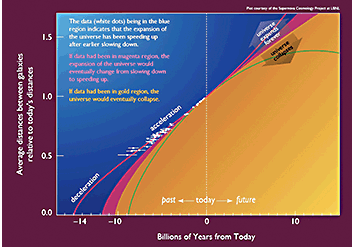
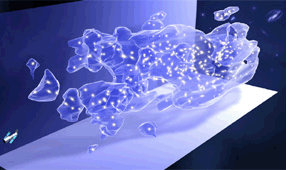
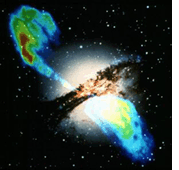
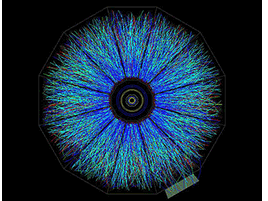
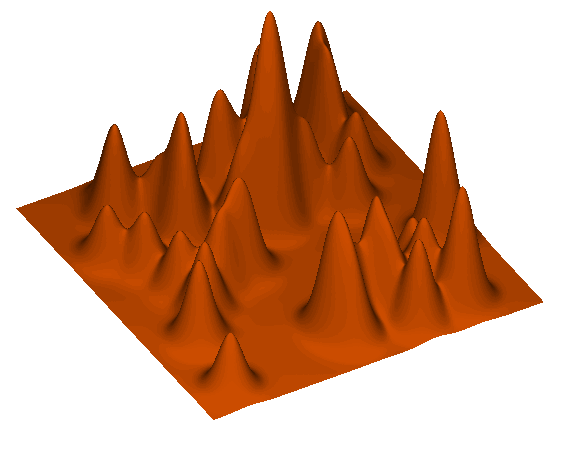
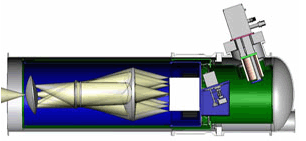


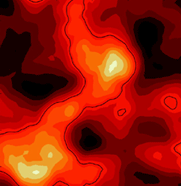 6)
6) 